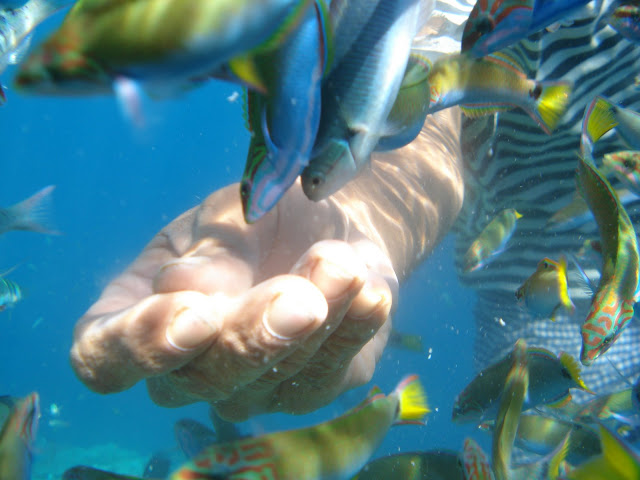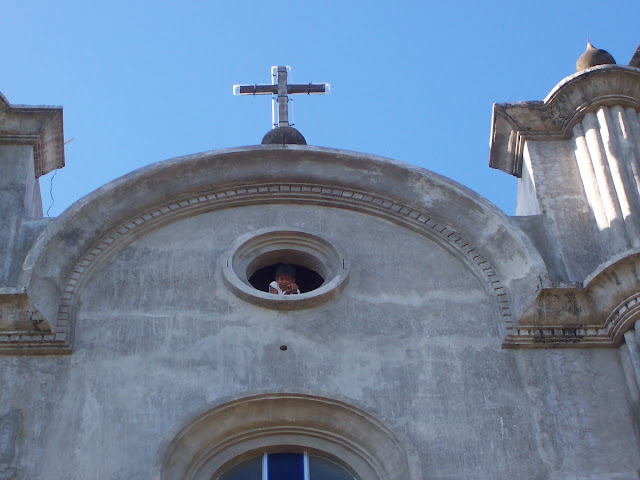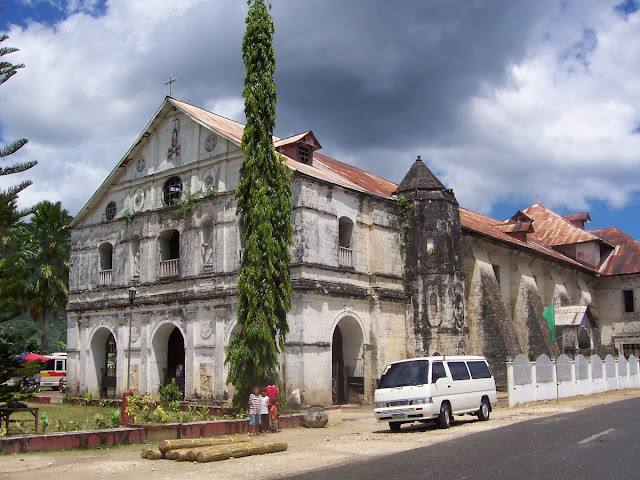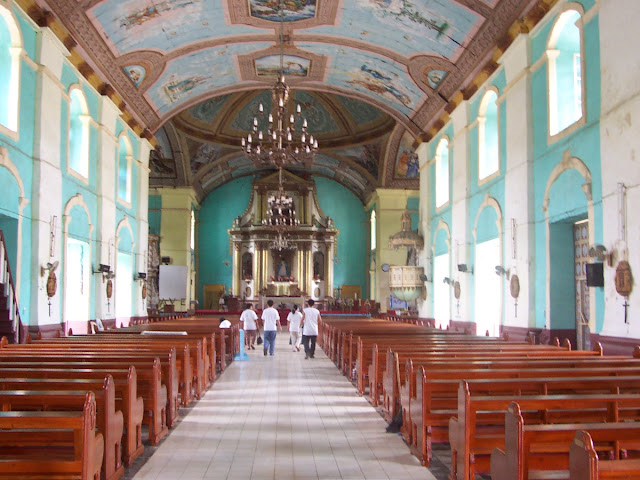In such a very compact place, no other island in the Philippines can offer a vacation which is both a nature trip and a pilgrimage as in Bohol. For sea lovers, there are lots of white beaches that can be found all over the island. The famous, of course, is in the island of Panglao near Tagbilaran were most of the resorts are found. Recently, a good number of five star resorts have sprouted. For those not fond of the sea, nature has also endowed Bohol with other sights, like the famous Chocolate Hills, waterfalls, rivers and of course, a visit to see the Tarsiers, the smallest monkeys in the world.
Just as a visit to Europe would always entail visits to magnificent churches and cathedrals, Bohol also has its own share. Old baroque churches are found and preserved in almost every town, thanks to the absence of typhoons in these parts and perhaps also to the poverty of the place, that they were left untouched with the flurry of renovations in other parts of the country in the 70's unmindful of their historic values.
For a traveler on a tight budget Bohol could be the place. The island is accessible by land, sea or air. Traveling in Bohol is no longer a hassle as the roads all around the island have already been cemented. From Cebu one can take the Supercat boat to Tagbilaran which takes two hours. But the cheapest way is to take the boat which goes to Tubigon, Bohol which also takes about two hours but only for over a hundred pesos. Almost every hour there are trips leaving for Tubigon from Cebu. From Tubigon you can start the tour of the island, either going first to the Chocolate Hills which is in the middle part of the island or go straight to Tagbilaran taking the seaside route. For those of us coming from Leyte, there is already a cheaper and direct way of going there without anymore passing by Cebu. Thanks to the nautical highway project of President Arroyo, there is already, aside from the boats, a ferry service from Bato, Leyte to Ubay in Bohol. It takes just over two hours. You pay 1,720 pesos for the car and 205 for the passenger in the aircon lounge.
Just as a visit to Europe would always entail visits to magnificent churches and cathedrals, Bohol also has its own share. Old baroque churches are found and preserved in almost every town, thanks to the absence of typhoons in these parts and perhaps also to the poverty of the place, that they were left untouched with the flurry of renovations in other parts of the country in the 70's unmindful of their historic values.
For a traveler on a tight budget Bohol could be the place. The island is accessible by land, sea or air. Traveling in Bohol is no longer a hassle as the roads all around the island have already been cemented. From Cebu one can take the Supercat boat to Tagbilaran which takes two hours. But the cheapest way is to take the boat which goes to Tubigon, Bohol which also takes about two hours but only for over a hundred pesos. Almost every hour there are trips leaving for Tubigon from Cebu. From Tubigon you can start the tour of the island, either going first to the Chocolate Hills which is in the middle part of the island or go straight to Tagbilaran taking the seaside route. For those of us coming from Leyte, there is already a cheaper and direct way of going there without anymore passing by Cebu. Thanks to the nautical highway project of President Arroyo, there is already, aside from the boats, a ferry service from Bato, Leyte to Ubay in Bohol. It takes just over two hours. You pay 1,720 pesos for the car and 205 for the passenger in the aircon lounge.

One of the popular activities that can be done in Panglao is dolphin and whale watching. Just recently we decided to go to Pamilacan island which is 23 kilometers from Panglao. In going there we did not get to see a whale or a dolphin. We thought we would no longer see one. But on our way back from Pamilacan going to Balicasag, a group of whales which were swimming in pairs came out. Our guide said they were pilot whales.
 In the shallow waters of Pamilacan just near the seashore one can already see a steady growth of corals and sponges.
In the shallow waters of Pamilacan just near the seashore one can already see a steady growth of corals and sponges. Ruins of an old watchtower is found in Pamilacan island. The island has a marine sancturay on one side of the island. When we were there, they just allowed visitors for 5o pesos each to go and snorkel around. In the middle part of the sanctuary where the bouys were, one had a beautiful view of fishes and corals just where the sea would suddenly drop like a cliff.
Ruins of an old watchtower is found in Pamilacan island. The island has a marine sancturay on one side of the island. When we were there, they just allowed visitors for 5o pesos each to go and snorkel around. In the middle part of the sanctuary where the bouys were, one had a beautiful view of fishes and corals just where the sea would suddenly drop like a cliff. 

A visit to Bohol would not be complete without seeing the Chocolate Hills. They have developed two places where one can see them. One is near Carmen, the original and the other is in Sagbayan. You can pass by Sagbayan if you are on the way to Tubigon.

With Frs. Benz, Roy and Mannix and our two secretaries from the Ormoc parish Gingging and Raquel at the Blood Compact site in Bool.
 With Frs. Lito, Dennis, myself (sitting) Randy and Yengyeng (standing) at the Blood Compact site during our latest visit.
With Frs. Lito, Dennis, myself (sitting) Randy and Yengyeng (standing) at the Blood Compact site during our latest visit.
With the Sto. Niño parish staff taking the Loboc river cruise.

ASSUMPTION OF OUR LADY SHRINE-PARISH (F-1697)Dauis, Bohol

Belfry of Dauis
Convento of Dauis
There are two towns in the island of Panglao: Dauis and Panglao. Noteworthy in the church of Panglao are its paintings. It would seem that the ceilings have several mouldings only to find out that they are just paintings on closer inspection. By the communion rail of the church of Dauis is a well that has not run dry even in the times of drought. Many consider it as medicinal. Here our office staff (below) brought with them bottles of water from the well.

 The picture above is from the early 18th century or late 17th cent. convento of Dauis. It is a huge convent which still retains its original wooden floors and boards. In the dome shaped refectory, paintings are still on the ceilings. Fr. Val Pinlac, the parish priest treated us for a dinner in the beautiful setting by the veranda of the old convento.
The picture above is from the early 18th century or late 17th cent. convento of Dauis. It is a huge convent which still retains its original wooden floors and boards. In the dome shaped refectory, paintings are still on the ceilings. Fr. Val Pinlac, the parish priest treated us for a dinner in the beautiful setting by the veranda of the old convento.ST. AUGUSTINE PARISH (F-1782)
Panglao, Bohol
 The parish church of Panglao. A separate belfry and watchtower stands near the back part of the church.
The parish church of Panglao. A separate belfry and watchtower stands near the back part of the church.ST. NICHOLAS DE TOLENTINO PARISH (F-1750)
Dimiao, Bohol
The statue of St. Nicholas de Tolentino enshrined at the facade of the church just above the main door.

IMMACULATE CONCEPTION PARISH (F-1596)
Baclayon, Bohol
ST. ISIDORE THE FARMER PARISH (F-1854)
Alburquerque, Bohol
OUR LADY OF THE HOLY ROSARY PARISH (F-1869)
Lila, Bohol
HOLY INFANT PARISH (F-1871)Valencia, Bohol

In front of the old convento of Valencia
MOST HOLY TRINITY PARISH (F-1799)Loay, Bohol

ST. PETER THE APOSTLE PARISH (F-1596)
Loboc, Bohol
The church of Loboc. One interesting sight in Loboc is its unused bridge. The bridge has crossed the Loboc river alright (the last post could be seen at the right of the above picture). But then it is supposed to traverse the present road and if it was continued it would have directly hit the main body of the old church. Was it just a wanton disregard of the historic importance of that Baroque church or just sheer stupidity that made the builders construct it, is a question often asked. Good the project was discontinued. It's really a lot of money wasted, but anyway it has become a good conversation piece
 The interior of the Tagbilaran Cathedral.
The interior of the Tagbilaran Cathedral.ST. ISIDORE THE FARMER PARISH (F-1854)Tubigon, Bohol

 Alona beach where most of the resorts are found.
Alona beach where most of the resorts are found. Dumaluan beach just near the Bohol Beach Club has a wide sandy white shore. The sea grasses in this part are further away from the shore, hence it is ideal for bathing especially for children, in comparison with the Alona beach.
Dumaluan beach just near the Bohol Beach Club has a wide sandy white shore. The sea grasses in this part are further away from the shore, hence it is ideal for bathing especially for children, in comparison with the Alona beach. STO. NIÑO PARISH (F-1858)
Anda, Bohol
 The church of Anda with its painted ceilings (below)
The church of Anda with its painted ceilings (below)
ST. JOSEPH PARISH (F-1857)Candijay, Bohol
OUR LADY OF CONSOLATION PARISH (F-1787)Guindulman, Bohol
IMMACULATE CONCEPTION PARISH (F-1872)
Duero, Bohol
 The church of Duero (above) and its pulpit, with Fr. Yeng Tabada posing (below). What makes this church special is that it has wooden floor boards that you can no longer find in any church; even the walls are still made of wood covered on the outside with galvanized sheets.
The church of Duero (above) and its pulpit, with Fr. Yeng Tabada posing (below). What makes this church special is that it has wooden floor boards that you can no longer find in any church; even the walls are still made of wood covered on the outside with galvanized sheets.
ST. MICHAEL THE ARCHANGEL PARISH (F-1876)
Jagna, Bohol
ST. JOHN THE BAPTIST PARISH (F-1859)Garcia Hernandez, Bohol
The pulpit of Garcia-Hernandez parish church.
 Balicasag island is about 11 kilometers from Panglao. Here, one can find the most spectacular views for snorkeling and scuba diving. Just near the island shore the sea drops off vertically and on its sides one can see varied corals and thousands of fishes of all kinds, big and small.
Balicasag island is about 11 kilometers from Panglao. Here, one can find the most spectacular views for snorkeling and scuba diving. Just near the island shore the sea drops off vertically and on its sides one can see varied corals and thousands of fishes of all kinds, big and small. 



 Even if you just stretch your hands fishes would already come near to feed.
Even if you just stretch your hands fishes would already come near to feed. 


A cheaper way to have a picnic in Balicasag instead of having it from the resort's restaurant is by just buying fresh seafood from the locals. They are ever ready to cook them for you.
 The town of Anda boasts of kilometers of white sand beaches. It is the next place that is being developed now after Panglao.
The town of Anda boasts of kilometers of white sand beaches. It is the next place that is being developed now after Panglao. Flower Beach in Anda (above and below)
Flower Beach in Anda (above and below)
 The first resort to open in Anda is the Dapdap Beach Resort.
The first resort to open in Anda is the Dapdap Beach Resort. Bohol Tropics in Tagbilaran is among the best in the city.
Bohol Tropics in Tagbilaran is among the best in the city.
 Bohol is composed of two dioceses: Tagbilaran and Talibon. The picture above is the Cathedral church of Talibon shown with the car we used to tour around the island.
Bohol is composed of two dioceses: Tagbilaran and Talibon. The picture above is the Cathedral church of Talibon shown with the car we used to tour around the island.

















































































2 comments:
hi i really loved reading your blogs.. and seeing the pictures of the explorations you made in our country.. wow! i am so amazed of what Philippines has to offer.. I just want to thank you because you indeed helped me in making a list of vacation destinations me and my family would love to go.. keep it coming and I will be you no. 1 follower.. =)
I love your blog! :D
I am beach fanatic too :D
Post a Comment